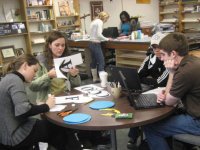Student-Centered Learning Environments: How and Why
Editor's Note: Paul Bogdan was once an old-fashioned lecturing teacher centered secondary math teacher who left teaching for 14 years to build computer systems. He has come back and is reborn as a student-centered teacher trying to make a difference and trying to figure out what works in today's classroom. (Updated 01/2014)
Education in our middle schools and high schools these days is rapidly changing. The old notion of a classroom where the students are sitting quietly and neatly in their seats, while the teacher is up front pouring pearls of wisdom and knowledge into their brains is absurd.
Reality in the 21st century is quite a different story. Students seem to know that once a teacher stands up in front of the room and starts "teaching," not only is their life going to get very boring very quickly, the end result will be that there will be more quizzes and tests to fail and more opportunities to end up feeling dumber and dumber. So, how do they cope? They text their friends or get some sleep, or interrupt the teacher with a myriad of cleverly constructed distractions. The teacher who intends to stand in front of a high school or middle school class and "teach" is in a constant battle.
Unfortunately, not all problems have easy solutions. Our students come into the classroom with the same attitudes and expectations as the society in which they live. How could it be otherwise? For many people in America, the Dream Job is one in which they are required to do very little work and get paid mega bucks for doing it. The main objective at work for some people is to avoid work. By example, our youth are taught these same values, or lack thereof. They simply do not understand that education will not occur if they don't get involved. They don't understand that their education is both their responsibility and their right.
The good news, however, is that not all students are so unaware. More and more of society at large, and consequently many students, are demanding an educational system that works for and with them. These students are not bored. They are very curious, eager to learn, and willing to do whatever it takes to learn. I believe that the student-centered learning environment enables an educator to deal effectively with all types of students in the same classroom. A student-centered learning environment encourages students to become independent learners and ultimately to be in charge of their own education.
Are teachers obsolete? Absolutely not. But, an educator's role is changing from the traditional "imparter of knowledge" to that of coach and consultant. There are many exciting examples of successful strategies and programs in which the students are not only allowed, but encouraged and required, to take responsibility for much more of their learning than ever before.
Do-it-yourself, student-to-student teaching, project-based learning, and student-centered learning environments are some of the more encouraging programs. Also, the integration of technology into every subject and at all grade levels allows unprecedented levels and types of exciting collaboration and learner to learner connectivity.
The following are some links to posts by authors who have written about these methodologies.
Do It Yourself (DIY)
Empowering Teachers with DIY (Article, Edutopia)
Room to Learn: An Italian Makeover (Article, Edutopia)
Open Source: A Do-It-Yourself Movement to Change Education from the Bottom Up (Article, Edutopia)
Student-to-Student Teaching
Report from EduBloggerCon at ISTE10: Trends and Tools (Article, Edutopia)
Does your school have a student-to-student mentoring program? (Poll, Edutopia)
Wisdom of the (Multi) Ages: Students Learn by Teaching (Article, Resource)
Project Based Learning (PBL)
PBL Resources (Edutopia Resource)
Introduction to PBL (video)
Ten Steps to Better Student Engagement (Article, Edutopia)
Student-Centered Learning
Student-Centered Learning Strategies for Math and Other Subjects (article)
Student Centered Teaching and Learning (Article, North Carolina State University)
Susan Sample and Student Center-Learning (Video)
Integrating Technology
A Day in the Life of a Connected Classroom (Article, Edutopia)
How Will Technology Change Learning -- and Teaching? (Article, Edutopia)
The Right Way to Use Technology in the Classroom (Article, President Kahn Academy)
"I never teach my pupils; I only attempt to provide the conditions in which they can learn." -- Albert Einstein
It takes a giant leap of faith for a teacher to think that their students can learn the material on their own. Teachers become teachers to teach. It is natural for the teacher to want to force the student to learn. But, this is similar to trying to force the proverbial horse to drink. Think about how many video games people have learned and won, on their own! No one had to "teach" them how; no one had to force them to play. Tina Barseghian wrote a great article about video games and the wisdom that educators can glean from them. In this article she writes the following.
REDEFINE TEACHERS AS LEARNING DESIGNERS. Game designers create well-designed experiences and social interactions. Teachers are designers of learning, and can create experiences tailored to suit their outcome. If we "re-professionalize" teachers as designers, they can create their own scripts for what they want students to learn.
When educators can design learning environments well enough, students will be able to learn mostly on their own. In an environment where the educator is respected for their expertise, and appreciated for their faith in the student's abilities, they will be asked for their help, encouragement and clarification when the student needs it. In turn, the students are appreciated for their willingness to take responsibility, become involved, and do the work needed to succeed. Mutual trust and respect is created rather than confrontation. Change is inevitable and there is a bright new hope on the educational horizon.
